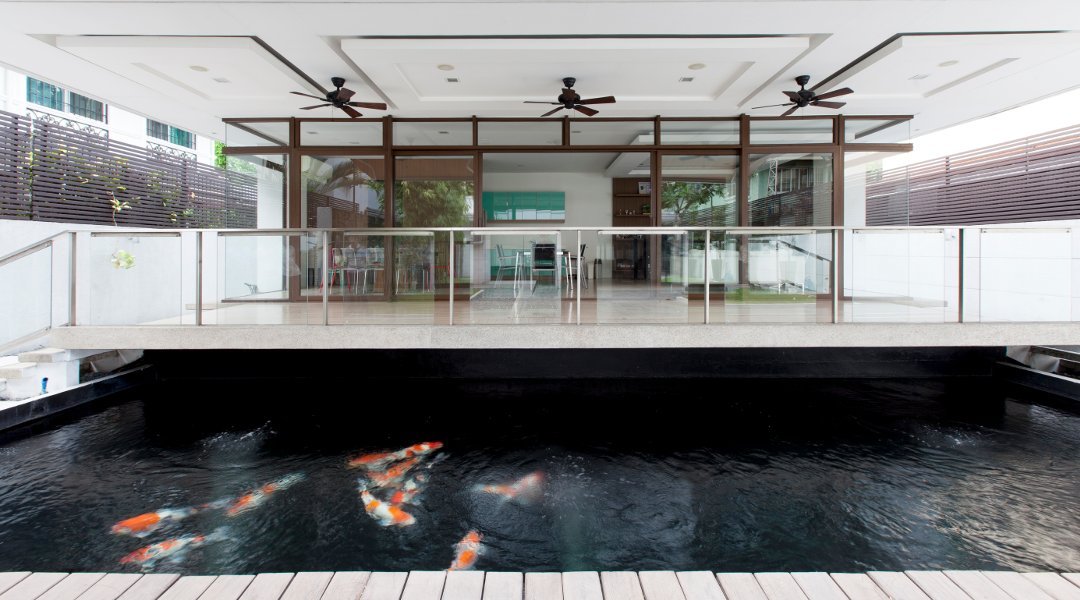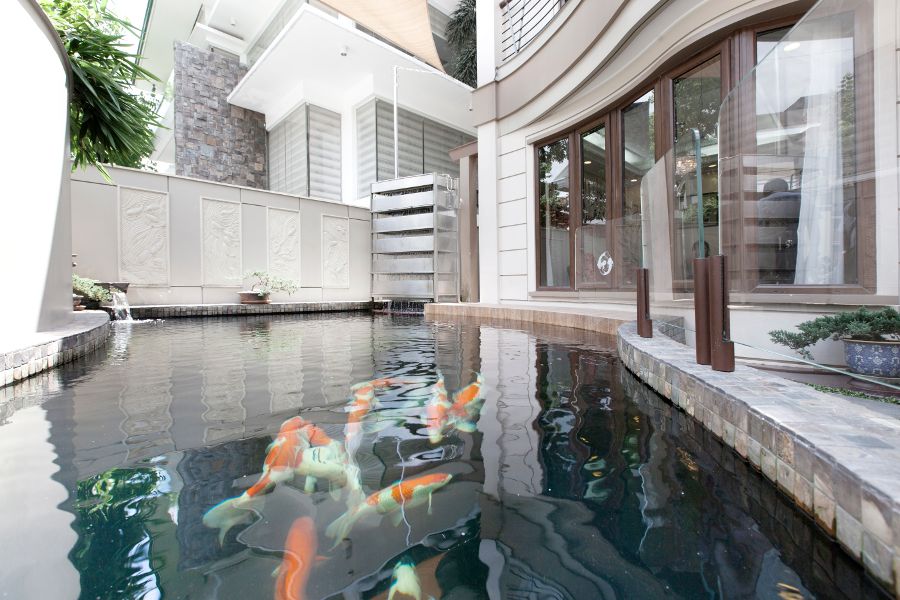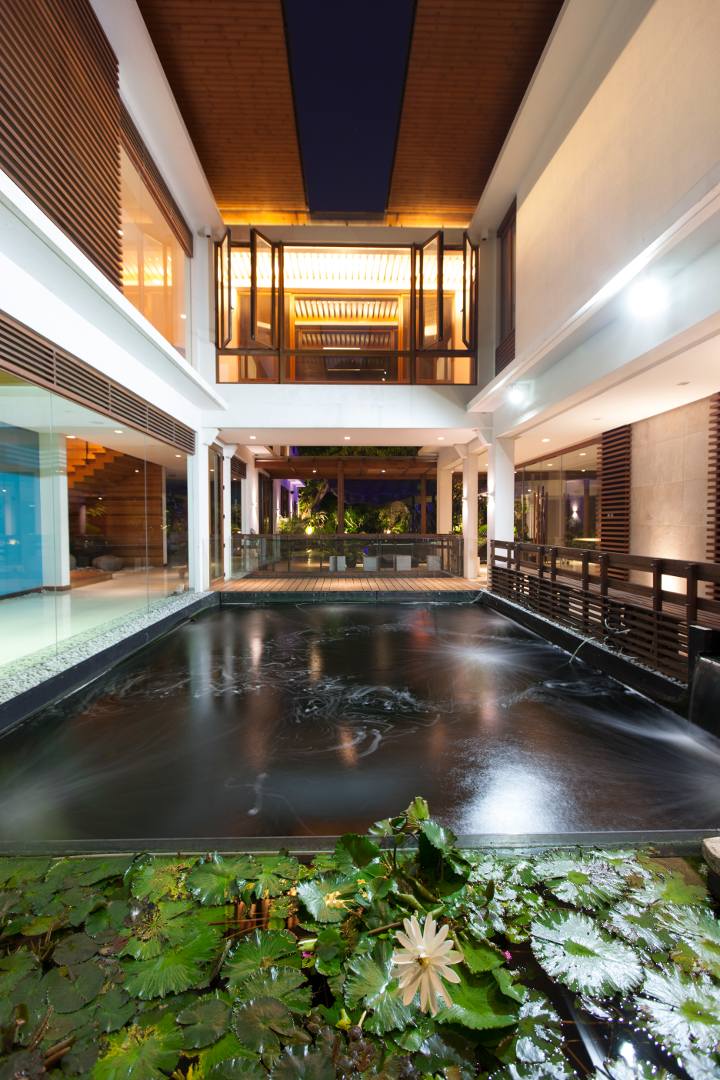
A short history of and five principles for designing koi ponds
Mesmerizing. The sight of koi gracefully gliding through water compels us to admire these living jewels as they seemingly invite us into their realm of peace and quiet. Koi have captivated man since ancient times, first in China, and then in Japan, where the art of koi ponds and breeding have reached unequaled greatness.

History of koi and koi ponds
Koi or nishikigoi (literally, “brocaded carp”) do not occur naturally in the wild. In the 1800s, carp or magoi were introduced to Japan from China. They were grown primarily for food; and then, as now, were colored black. The Japanese rice farmers in Yamakoshi who raised magoi noticed that some offspring had blotches of color, and so set them aside as pets. These unusually colored carp kept them entertained during the long intermissions that rice farming imposes. The plain-looking magoi, on the other hand, ensured that they always had something on the table to eat.
Over time, by human design, different breeds of koi came into being. The first record of colored carp in Japan was in 1843 when three breeds—Asagi, Bekko and Sarasa (Kohaku)—were identified. The turn of the 20th century was the beginning of the Japanese’s intense, impassioned pursuit of breeding of koi. Today, the magoi or parent carp is widespread across Japan’s rivers, streams and lakes. Yet its colored progeny, the nishikigoi, have invaded not just Japan but much of the world, captivating untold numbers as if by a spell. In stark contrast, the story of koi pond building is a history ridden with frustration, desperation and disappointment, with untold numbers of the precious animals unable to survive their new habitation; that is, until the last decade when advances were made in the design of koi pond filters and koi ponds.
READ MORE: Shophouse by RT+Q becomes urban street lantern at night
Prevalent Pitfalls
Building a koi pond is an architectural sub-specialty in itself not taught in our universities, but learned in the hobbyist’s school of trial and error. Faults in pond design are widespread. Typically, a faulty design is passed on from one builder or hobbyist to another, with the assurance that one can always renovate the pond or tweak the design later. Throughout the endless pursuit of a dream pond, many fish and money are lost along the way. While the Internet is a wonderful source of information, it is also the source of confusing and downright irrational theories about koi. The most common problems in koi pond building are:
- Flawed filter system design
- Building a pond without proper steel reinforcements and water proofing, which can result in persistent leaks
- Building a pond with sharp or angled corners (as in a swimming pool) that produce dead spots where water cannot circulate, and so collect and accumulate debris
- Incorporating structures with sharp edges and surfaces that can scrape a koi’s skin
- Building an outdoor pond that is too shallow or too narrow for the fish to swim in
- Building it in a location under full sun, which creates an environment too hostile for koi
- Having aquatic plants in the koi pond. Koi are omnivores and will eat or nibble at water lilies or lotuses. If it were possible to physically isolate the plants from koi, it still wouldn’t be practical since pond water is occasionally salted to eradicate koi parasites or treat disease, and the salinity of the water will surely exterminate the plants as well. Should the owner insist on having aquatic plants, they may be placed in an adjoining but completely separate pond.
- Lack of disclosure by sellers to buyers of koi that these beautiful beings make for high-maintenance pets

Practical Principles
The quality and price of the koi tend to be determining factors in choosing the design and type of pond to be built. Koi prices range from 200 to 2 million pesos. But whether one is a casual keeper of koi who just wants a water feature for his home, or a passionate hobbyist, it is to his and his koi’s best interests to fulfill the irreducible minimums of a koi pond. The following guidelines have been distilled from the collective experience of the KoiBois, a group of passionate koi keepers in the Philippines, and extracts from Peter Waddington’s definitive book on koi keeping, Koi Kichi 2.
1. An efficient filter system is of utmost importance to koi’s health and survival. While a koi pond and its filtration system may be structurally separate, the two are functionally one and can never be divorced. Some manufacturers claim to have filter systems requiring no maintenance, but the best systems are those which have the following components:
- Bottom drains – Partially covered pipes at the bottom of the koi pond where water from the pond exits and is moved to the filter system
- Skimmers – Placed about one centimeter beneath the pond surface, they suck in floating debris and deliver them to the filter system. Skimmers are indispensable in keeping the pond surface clean and glassy.
- Mechanical filter – The first in a series of filtering chambers is one where large debris like fallen leaves, fish waste and excess koi food are trapped by filter brushes or other suitable material
- Biological filtration – From the mechanical filter chamber, water is transferred to a biological filtration consisting of finer mesh where bacteria thrive. These microscopic organisms converting toxic metabolites to harmless, even beneficent compounds.
2. Ultraviolet light – Submerged ultraviolet lamps clarify pond water by breaking down microscopic algae that would otherwise render a pond green. It also helps to control the proliferation of harmful bacteria.
3. Pump – For water to move from the pond via the bottom drains to the series of chambers in the filter system, and then drive it back into the pond via a waterfall or a simple return pipe, a pump that works round the clock is employed.
4. Aeration – Since fish breathe by extracting oxygen from the water, pumps that blow air into diffusers or porous stones at the bottom of the pond are a must.
5. Temperature control – Koi thrive best in water temperature of 25°C. While tropical countries enjoy the benefit of not having freezing temperatures, they face the other extreme, which is overheating. Thoughtful placement of a pond or installation of shade sails can easily address this. For further cooling, a Bakki shower or chiller may be installed. Not many hobbyists employ these means, but it wouldn’t be surprising to see a chiller installed in a pond that houses koi worth millions of pesos.

Water
A koi pond is not a static pool of water but a dynamic, living habitat, governed by the laws of natural science. The goal is to approximate the ecosystem in which koi flourish. While magoi, the ancestor of koi, can tolerate a wide variation in water quality in the wild, it isn’t so for their human-selected, pedigreed descendants kept in a koi pond, a habitat that is artificial in every respect. There are far more important aspects of koi pond water than clarity, but for viewing one’s prized collection and overall attractiveness of the pond, it is the first thing people notice. To provide koi a habitat where they can develop to the maximum potential that their genes allow, here are some basics:
- Koi thrive best when the water temperature is at or around 25°C.
- Koi are intolerant of the accumulation of toxic waste products, namely, ammonia, nitrites and nitrates. When the concentration of these metabolites rise, koi growth is impeded, the brilliance of their colors begins to wane, their resistance to disease is compromised, and when allowed to further rise, may result in their death.
- Even with the most efficient filter systems, removing a percentage of water daily or weekly is mandatory—like flushing the toilet whenever there’s waste matter in it. Some hobbyists change 10% of pond water, while most change 30% once or twice weekly.

Dimensions
The ideal depth of a koi pond is 1.5 meters or more for optimal growth, and a surface area of 16 square meters seems to be the accepted minimum size. These dimensions translate to about 20 tons of water, excluding the water going through the filter system. For the serious hobbyist who wishes to grow huge koi, the rule of thumb is one koi per two tons of water. A 20-ton pond can thus accommodate 10 koi. However, if the owner wishes to keep smaller koi, of lower grade but beautiful nonetheless, a 20-ton pond can sustain up to 40 koi.
Viewing koi
Unlike other fish, koi are best viewed from above, rather than from the side, as in an aquarium. This is because their beautiful patterns, some highly coveted, are on the dorsal or upper side of the fish. When a koi pond is seamlessly integrated in a part of a house that is designed for relaxation, the koi’s vivid colors and graceful movements appear to have been created just for that purpose.
Koi and other fish
Generally speaking, a koi pond is designed with the intent of keeping just koi. Should the owner wish to have other kinds of fish, the larger goldfish like Sabao and Tamasaba can co-exist with koi. But carnivorous fish like arowana and arapaima may lead to the extinction of one’s koi collection.
Designing and building a koi pond the right way can spell the difference between delight and disaster. Failure to recognize and fulfill the most basic requirements can turn a koi pond project into a cascade of problems that the pond owner will have to face on his own, when the architect and contractor have gone their way. Built right, koi ponds will exceed all expectations of the joy and contentment that caring for these magnificent creatures can bring. ![]()

Frequently Asked Questions
Can I build a pond indoors? Yes, provided there is adequate ambient light or a few hours of filtered sunlight for beneficial algae to grow.
What is the minimum depth of a koi pond? If designed primarily as a water feature, with no intention to buy high-end koi or to grow them big, a depth of one foot might be enough. But for those who wish for their koi to grow optimally, a depth between 3 to 5 feet is an acceptable minimum.
Since a filter system takes up so much space, for what other purpose can I use that space? A detachable wooden deck over the filter chambers can serve as a walkway or a feature by itself if executed well.
Are there koi pond designers, builders or resources for building koi ponds in the Philippines? Yes. A good place to start is Koi Hob in White Plains, Quezon City.
How much does it cost to build a 20-ton pond? Anywhere from P250,000 to P350,000.
How much does it cost to run and maintain a 20-ton pond? Typically, P3,000 on electricity and about P2,000 on water per month. A bag of good koi food costs about P2,000 and can last up to four months.
Is there a truly maintenance-free koi pond? No.
If I want a koi pond but don’t have the time to maintain it, are there pond maintenance services available? Yes. Koi Hob in White Plains offers such service. Typically, pond maintenance service costs P1,000 per visit. One or two visits per month is recommended. In between visits, household staff can do simple pond maintenance like water changes and filter cleaning.


